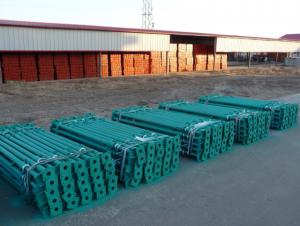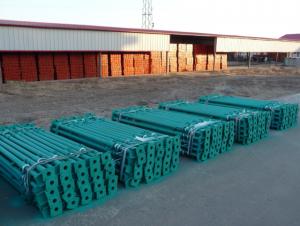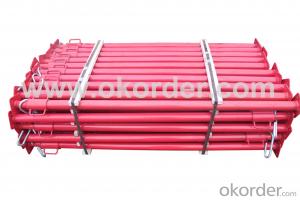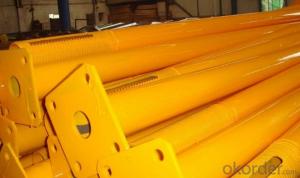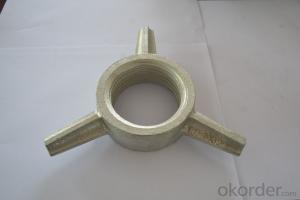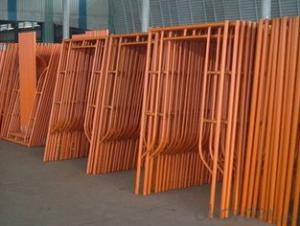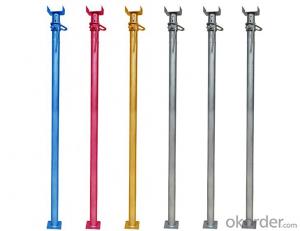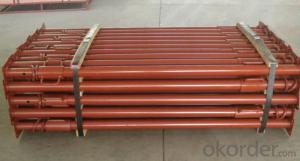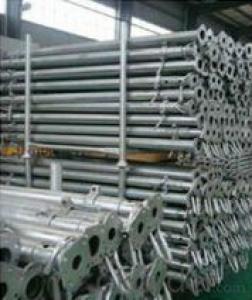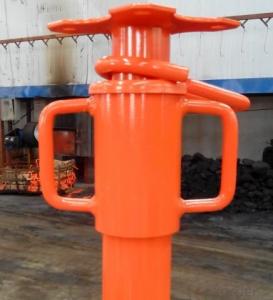Frame Scaffolding System, Scaffolding and Formwork System ,H Frame Scaffolding
- Loading Port:
- China Main Port
- Payment Terms:
- TT or LC
- Min Order Qty:
- 1000 Set/Sets pc
- Supply Capability:
- 10000 pc/month
OKorder Service Pledge
OKorder Financial Service
You Might Also Like
Quick Details
Place of Origin: Tianjin, China (Mainland)
- Model Number: SD1700/1930CGSP
Place of Origin: China (Mainland)
Type: Scaffolding Parts
Scaffolding Part Type: Scaffolding Props
Color: blue/green/red/brown
Height: 1700/1930mm
Steel Pipe Size: 25/42
Coated: Painted;Pre-Galvanized; Electro Galvanized
Material grade: Q195-Q235
Package: Bundles or in Bulk
Certification: ISO9001:2008

Packaging & Delivery
| Packaging Details: | 1- Frame scaffolding system is packed in bundle and wrapped with iron bar . 2- Usually , one 40HQ container can load 300-600 set of props , |
|---|---|
| Delivery Detail: | 40days |
Specifications
Frame scaffolding system is easy to assemble and dismantle which can help to save your time , energy and cost .
Product Description
scaffolding and formwork system
A- An adjustable steel prop including inner tube, Outer tube , prop nut ,prop pin , base plate and top plate
B- Adjustable steel prop can be adjusted to any length within its range which is convenient for using
C- Adjustable steel prop is easy to assemble and dismantle which can help to save your time , energy and cost .
D-We have several kinds of adjustable steel prop which are Middle East type adjustable steel prop , Spanish adjustable steel prop ,and Italian type adjustable steel prop . They are popular in Africa , South America , Middle east etc.
E-Adjustable steel prop is for supporting concrete slab , beam , timber and formwork which is strong and reliable for interior building construction .
F- we can weld the flat plate or the flower plate, or U-head plate , or fork plate at the top of the adjustable steel prop as your request .
scaffolding and formwork system
- Q:What are the different types of steel used in steel props?
- Steel props used in construction can be made from various types of steel, each possessing unique properties and advantages. Let's explore these different types: 1. Mild Steel: Widely utilized in steel props, mild steel stands out for its low carbon content, enabling excellent weldability and formability. These props are cost-effective and readily available, making them a popular option for construction projects. 2. High-strength Low-alloy (HSLA) Steel: By combining carbon steel with small amounts of elements like vanadium or niobium, HSLA steel props offer enhanced strength and superior performance compared to mild steel props. They find great utility in applications requiring additional strength and durability. 3. Stainless Steel: Suited for environments with high humidity or exposure to chemicals, stainless steel props exhibit corrosion resistance and high strength. They are commonly employed in marine construction, food processing plants, and other corrosion-sensitive settings. 4. Carbon Steel: With a higher carbon content than mild steel, carbon steel props deliver increased strength and hardness. These props are ideal for heavy-duty applications demanding high load-bearing capacity, such as supporting large structures or heavy machinery. 5. Alloy Steel: Alloy steel props are created by introducing alloying elements like manganese, chromium, or nickel to carbon steel. This improves their mechanical properties, including strength, hardness, and wear resistance. They find widespread use in industrial settings, construction machinery, and mining equipment. 6. Tool Steel: Designed for exceptional hardness, toughness, and wear resistance, tool steel props excel in applications where they must endure heavy impacts or extreme wear. They are commonly employed in forging dies, cutting tools, or molds. Each type of steel possesses its own strengths and weaknesses, and the selection of steel for steel props hinges on specific project requirements, including load-bearing capacity, corrosion resistance, and cost-effectiveness.
- Q:What are the potential ergonomics concerns when using steel props?
- When steel props are utilized, there are several ergonomic issues that need to be taken into account. Firstly, the weight of steel props can be quite significant, especially if they are larger in size. This can create a risk of musculoskeletal injuries such as strains and sprains, particularly when lifting or moving the props. Another issue to consider is the difficulty in handling steel props due to their size and shape. They may require bending or reaching in uncomfortable positions to properly position or secure them, which can result in discomfort or injury over time. Additionally, if not handled carefully, the sharp edges or protrusions on steel props can cause cuts or abrasions. Moreover, using steel props without adequate support or padding for an extended period can lead to pressure points and discomfort, potentially causing problems like pressure sores or nerve compression. To address these ergonomic concerns, it is important to implement appropriate measures. This may involve providing training on proper lifting techniques, using mechanical aids or assistance when moving heavy steel props, and ensuring that workers have access to suitable personal protective equipment, such as gloves, to minimize the risk of cuts or abrasions. Furthermore, considering the design and materials of the props can help mitigate ergonomic concerns. For example, using props with ergonomic handles or grips can improve handling and reduce strain on the hands and wrists. Additionally, employing props with rounded edges or padding can also minimize the risk of pressure points and discomfort during prolonged use. In conclusion, being mindful of the potential ergonomic issues when using steel props and implementing suitable measures to address them is vital for ensuring the safety and well-being of workers.
- Q:Can steel props be used for supporting temporary sound and lighting equipment?
- Yes, steel props can be used for supporting temporary sound and lighting equipment. Steel props, also known as adjustable steel props or acrow props, are commonly used in construction to support temporary structures, such as scaffolding, formwork, and falsework. They are designed to provide vertical support and can be adjusted to different heights, making them versatile and suitable for various applications. When it comes to supporting temporary sound and lighting equipment, steel props can be an ideal choice. They offer stability and strength, ensuring that the equipment is securely held in place. Additionally, steel props have a high load-bearing capacity, allowing them to support heavy equipment without any risk of collapse or instability. Furthermore, steel props are easy to set up and adjust, making them convenient for temporary installations. They can be quickly assembled and can accommodate different heights and configurations, allowing for flexibility in positioning the sound and lighting equipment as required. It is important to note that while steel props are suitable for supporting temporary sound and lighting equipment, proper planning and assessment of the load-bearing requirements should be carried out. The weight of the equipment and the height at which it will be positioned should be considered to ensure that the steel props used are of the appropriate size and strength. In summary, steel props can be effectively used for supporting temporary sound and lighting equipment. Their strength, stability, adjustability, and ease of setup make them a reliable choice for securely holding such equipment in place.
- Q:Can steel props be used for supporting temporary aerial platforms or lifts?
- Supporting temporary aerial platforms or lifts can be achieved using steel props. These props, also referred to as adjustable steel props or scaffolding props, are commonly utilized in construction projects to offer temporary support for structures or platforms. Their adjustable height feature makes them suitable for various applications, including supporting aerial platforms or lifts. Steel props are renowned for their strength and stability, making them a dependable choice for establishing a secure and sturdy foundation for temporary platforms or lifts. Moreover, their height can be easily modified, providing flexibility in determining the desired elevation for the platforms or lifts. However, it is imperative to ensure the proper installation of steel props and adherence to required safety standards to guarantee the safety of workers and the stability of the supported structure.
- Q:Can steel props be used in the installation of temporary safety barriers or guardrails?
- Yes, steel props can be used in the installation of temporary safety barriers or guardrails. Steel props are commonly used to provide support and stability to temporary structures, including safety barriers and guardrails. They offer strength and durability, making them suitable for ensuring the safety of workers and the public during construction or maintenance activities.
- Q:What are the advantages of using steel props over other types of supports?
- There are several advantages to using steel props over other types of supports. Firstly, steel props offer superior strength and stability, making them capable of supporting heavy loads and ensuring safety on construction sites. Additionally, steel props are adjustable, allowing for easy customization to different heights and lengths, making them versatile and adaptable to various construction projects. Furthermore, steel props are durable and long-lasting, with a high resistance to rust and corrosion, making them reliable and cost-effective in the long run. Overall, steel props provide a reliable, strong, and flexible support system, making them a preferred choice in construction and engineering industries.
- Q:What are the common safety certifications or standards for steel props?
- There are several common safety certifications and standards for steel props that ensure their quality and reliability. These certifications and standards are essential in ensuring that steel props meet certain safety criteria and are fit for use in construction projects. Some of the common safety certifications and standards for steel props include: 1. EN 1065: This European standard specifies the requirements for adjustable steel props used as temporary supports in construction. It covers aspects such as load-bearing capacity, dimensional tolerances, and material specifications. 2. BS 4074: This British standard provides guidance on the design, testing, and use of adjustable steel props in construction. It includes requirements for load capacity, stability, and safe working practices. Compliance with BS 4074 ensures that steel props meet the necessary safety standards in the UK. 3. ANSI/ASSE A10.9: This American National Standard sets forth safety requirements for the use and construction of temporary shoring, including steel props. It covers aspects such as capacity, design, installation, inspection, and maintenance of shoring systems. Compliance with this standard ensures that steel props used in the US meet the necessary safety criteria. 4. OSHA regulations: The Occupational Safety and Health Administration (OSHA) in the United States sets forth regulations and safety standards for various aspects of construction, including temporary support systems like steel props. Compliance with OSHA regulations ensures that steel props meet the necessary safety requirements for use on construction sites in the US. 5. ISO 9001: This international standard focuses on quality management systems and ensures that the manufacturer of steel props follows stringent quality control processes. While ISO 9001 does not specifically address safety aspects, compliance with this standard gives confidence in the overall quality and reliability of the steel props. It is important to note that these are just some of the common safety certifications and standards for steel props. Depending on the country and specific project requirements, there may be additional regional or industry-specific certifications that need to be considered. It is always recommended to consult with local authorities, construction industry professionals, and manufacturers to ensure compliance with the relevant safety certifications and standards for steel props in a particular region or project.
- Q:Can steel props be used for temporary support in bridge pier construction?
- Steel props are a viable option for providing temporary support in the construction of bridge piers. They are frequently employed in construction endeavors to offer temporary support to structures throughout the construction process. These props can be easily adjusted and provide a dependable and robust support system. When it comes to bridge pier construction, steel props can bear the weight of the pier and guarantee its stability until permanent supports, like concrete piers or abutments, are established. Steel props possess versatility, as they can be adjusted to various heights and angles, making them suitable for a variety of bridge pier construction scenarios. Nonetheless, it is crucial to ensure that the design, installation, and monitoring of the steel props are done properly to ensure the safety and stability of the bridge pier during construction.
- Q:Do steel props require any special storage or handling procedures?
- Yes, steel props do require special storage and handling procedures. They should be stored in a dry and well-ventilated area to prevent rusting and corrosion. It is recommended to stack them vertically and secure them properly to avoid any accidents. Additionally, they should be handled with care, using appropriate lifting equipment, and never exceed their load-bearing capacity to ensure safety during transportation and usage.
- Q:Can steel props be used for supporting temporary fencing or barriers?
- Indeed, temporary fencing or barriers can benefit from the utilization of steel props. Renowned for their resilience and longevity, these props prove to be optimal for offering assistance to impermanent structures. They effortlessly bear the load of temporary fences or barriers, guaranteeing stability and safeguarding. Moreover, steel props possess the ability to be adjusted to varying heights, enabling adaptability when installing temporary fencing or barriers in diverse settings and terrains. All in all, steel props emerge as a trustworthy selection for supporting temporary fencing or barriers.
1. Manufacturer Overview |
|
|---|---|
| Location | |
| Year Established | |
| Annual Output Value | |
| Main Markets | |
| Company Certifications | |
2. Manufacturer Certificates |
|
|---|---|
| a) Certification Name | |
| Range | |
| Reference | |
| Validity Period | |
3. Manufacturer Capability |
|
|---|---|
| a)Trade Capacity | |
| Nearest Port | |
| Export Percentage | |
| No.of Employees in Trade Department | |
| Language Spoken: | |
| b)Factory Information | |
| Factory Size: | |
| No. of Production Lines | |
| Contract Manufacturing | |
| Product Price Range | |
Send your message to us
Frame Scaffolding System, Scaffolding and Formwork System ,H Frame Scaffolding
- Loading Port:
- China Main Port
- Payment Terms:
- TT or LC
- Min Order Qty:
- 1000 Set/Sets pc
- Supply Capability:
- 10000 pc/month
OKorder Service Pledge
OKorder Financial Service
Similar products
New products
Hot products
Hot Searches
